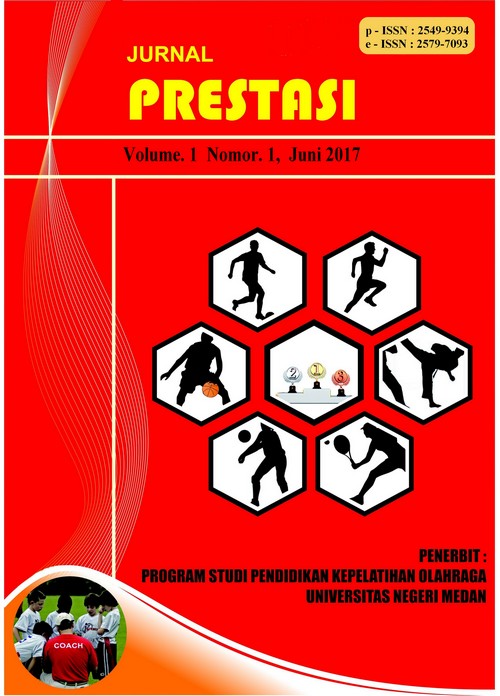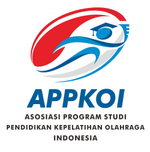PERBEDAAN PENGARUH HASIL BELAJAR SMASH SEPAK TAKRAW DENGAN MENGGUNAKAN METODE BOLA DIGANTUNG DAN BOLA DIUMPAN PADA MAHASISWA PKO
DOI:
https://doi.org/10.24114/jp.v1i1.6491Abstract
Penelitian ini bertujuan untuk mengetahui apakah terdapat perbedaan pengaruh hasil belajar smash sepak takraw dengan metode bola digantung dan bola di umpan pada Mahasiswa PKO Reguler Angkatan Tahun 2013. Populasi sebanyak 100 orang. Jumlah sampel 80 orang diperoleh dengan teknik Purposive Sampling. selanjutnya dibagi menjadi dua kelompok dengan teknik Matching Pairing. Instrumen penelitian untuk pengumpulan data dengan test dan pengukuran adalah test skor yang di lapangan test untuk kemampuan smash. Penelitian dilaksanakan selama 18 x pertemuan dengan metode 4 (empat) kali dalam seminggu. Untuk melihat pengaruh masing-masing variabel bebas maupun terikat digunakan perhitungan uji “ t berpasangan dan uji “ t tidak berpasangan. Analisis hipotes pertama I : Diperoleh t hitung sebesar 11 serta t tabel 2,02 dengan = 0,05 (t hitung > t tabel ) berarti Ho ditolak dan Ha diterima. Kesimpulan, metode bola digantung secara signifikan berpengaruh terhadap hasil belajar smash. Analisis hipotesis kedua : Diperoleh t hitung sebesar 6,76 serta t tabel sebesar 2,02 dengan = 0,05 (t hitung > t tabel ) berarti Ho ditolak dengan Ha diterima. Jadi, metode bola diumpan secara signifikan berpengaruh terhadap hasil belajar smash. Analisis hipotesis ketiga : Diperoleh t hitung sebesar 0,89 serta t tabel 1,99 dengan = 0,05 (t hitung < t tabel ) berarti Ho diterima dan Ha ditolak. Jadi, Secara signifikans Tidak terdapat perbedaaan pengaruh metode bola digantung dan metode bola diumpan terhadap hasil belajar smash pada mahasiswa PKO Reguler Angkatan tahun 2013. Kesimpulan kedua metode ini dapat dipakai untuk meningkatkan hasil belajar smash.Downloads
Published
2017-06-30
Issue
Section
Articles
License
Authors who publish with this journal agree to the following terms:
- Authors retain copyright and grant the journal right of first publication with the work simultaneously licensed under a Creative Commons Attribution License that allows others to share the work with an acknowledgment of the work's authorship and initial publication in this journal.
- Authors are able to enter into separate, additional contractual arrangements for the non-exclusive distribution of the journal's published version of the work (e.g., post it to an institutional repository or publish it in a book), with an acknowledgment of its initial publication in this journal.
- Authors are permitted and encouraged to post their work online (e.g., in institutional repositories or on their website) prior to and during the submission process, as it can lead to productive exchanges, as well as earlier and greater citation of published work (See The Effect of Open Access).
- This work is licensed under a Creative Commons Attribution-ShareAlike 4.0 International License.





















